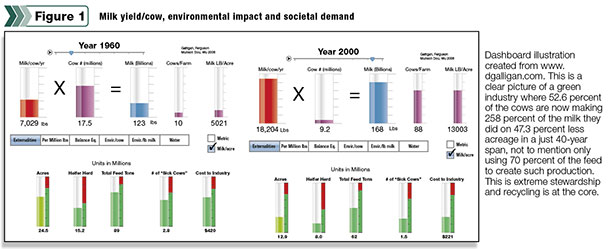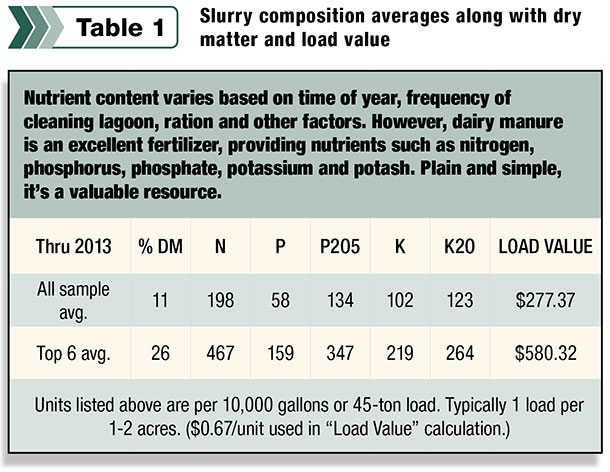Recycling is a major theme of the dairy industry, and we should hold our heads high because of the extent we are a “green” industry (Figure 1). Just like many of the byproducts we use in today’s rations, so too is the use of manure part of that case of extreme recycling. We are recycling what has already been recycled once.

Figure 1 is a dashboard illustration (created from David Galligan's web page). This is a clear picture of a green industry where 52.6 percent of the cows are now making 258 percent of the milk they did on 47.3 percent less acreage in just a 40-year span, not to mention only using 70 percent of the feed to create such production. This is extreme stewardship, and recycling is at the core.
The tough reality of today’s high feed cost is that the nutrients in your ration still are not being fully utilized by your cows. The higher the quality of feed you put in, matched with genetics, management and environment, the more you will convert into milk.
However, all is not lost after feed is converted to milk. What is captured post-digestion in the form of manure has tremendous value. Today’s modern dairy must maximize every dollar spent on feed, and recycling manure is a critical part of that business plan.
The more you know about what nutrients your manure can provide, the more strategically it can be used. Manure recycling strategies you implement can have long-term effects on your soil as well as the quantity and quality of your crop, not to mention the lasting effects on your herd’s foot health. Moreover, everything about recycling manure appropriately is helpful to your bottom line.
What manure are we talking about? And how do we know how valuable it us? Properly agitated and applied lagoon slurry has added benefits to double crops, legumes and your farming bottom line. In many parts of the country, regulations require regular sampling of your lagoon slurry, particularly in the West.
By collecting and tracking the composition of your slurry, you have the ability to apply it heavier or lighter depending on your crop needs, soil type and time of year. Once you have a handle on the composition of your slurry, simply put market value to the organic nutrients each slurry load will deliver.
Table 1 shows typical results seen in a modern Western dairy lagoon slurry samples and calculates the value of those nutrients using a percentage of the market cost if you were to purchase them off-farm.

With respect to double-crop fields, slurry adds moisture and recycles nutrients directly into soil. When slurry is properly applied to a double-crop field, the soil can be worked within a short time, allowing soil moisture for second crop germination, to some extent much like the effect of pre-irrigation.
Particularly in the West, slurry spreading between legume cuttings can provide the nutrients needed for next cutting, as well as moisture which may help speed up irrigation between cutting, baling and “road siding.”
One high-producing California Central Valley dairyman who uses this strategy on his legume fields suggests that in order to implement this strategy best, consider the time of year you apply slurry and the soil type; you may have more absorption in some seasons as opposed to others.
He also believes it is a system that helps his more mature stands to a larger extent than the younger stands. Soil compaction is a concern for some dairymen and farmers; however, flotation tires that spread the weight over a larger area of impact pose much less risk.
Application style is critical to get the most bang for your recycling buck. Slurry is quickly and consistently incorporated into your soil and across your fields. The moisture aids in absorption of nutrients by the soil and sets the stage for more rapid soil improvement.
Many farmers believe they get more consistent crop stands and hardier roots. Knowing the soil starting point, crop requirements and slurry composition helps you put together a plan to improve your soil, provide vital nutrients to the future crops, recycle and capture more value from feed dollars spent (not to mention cleaning the lagoon and improving herd foot health).
More and more farmers are seeing benefits of slurry between double crops and legume cuttings, and more and more dairymen are enjoying the benefits from a cow health standpoint.
Foot health is a major secondary benefit to recycling manure appropriately. The simple fact is that lagoons are cleaner when sludge and slurry can be removed regularly. Earthen lagoons often go decades before being cleaned completely.
This build-up not only reduces storage space but increases risk of bacterial transfer and compromised foot health in today’s high-producing cows.
Improving flush water cleanliness helps to reduce risk of disease transfer and lameness.Mild lameness has a 1 to 3 pound per head per day negative effect on milk production as reported by many notable studies.
Recycling or reclaiming your manure nutrients is just plain good stewardship of your feed dollars, but the lasting and far-reaching positive effects on herd health can mean big dollars to your bottom line through increases in production due to improved foot health. Ultimately, as your nutritionist, I want the best for your herd and your bottom line.
Explore what you can do on your farm to improve your soil between double or triple crops by knowing what your soil lacks, what your crops need and what your slurry can deliver. Just like anything else in business, the more you learn – the more you will earn. PD
Luciana Jonkman is a nutrition and management consultant with Progressive Dairy Solutions, Inc. Contact her by email.








